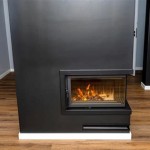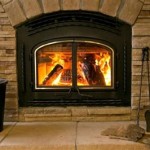Wood Pellet Insert For Gas Fireplace: A Comprehensive Guide
The concept of integrating a wood pellet insert into an existing gas fireplace is an innovative approach to home heating. This involves converting a gas fireplace, designed primarily for aesthetic purposes, into a more efficient and environmentally conscious heating appliance using wood pellets as fuel. This transition offers a blend of convenience, sustainability, and cost-effectiveness, attracting homeowners seeking alternatives to traditional heating methods. This article explores the intricacies of this conversion process, highlighting the advantages, challenges, and key considerations involved.
Gas fireplaces, while visually appealing and easy to use, are often criticized for their inefficiency. A significant portion of the heat generated escapes through the chimney, resulting in minimal warmth and higher energy bills. Furthermore, the burning of natural gas contributes to greenhouse gas emissions, raising environmental concerns. Wood pellet inserts offer a compelling solution by providing a more efficient and sustainable heating source. Wood pellets are made from compressed sawdust, wood shavings, and other wood waste products, making them a renewable and carbon-neutral fuel source. When burned, they release significantly less particulate matter and greenhouse gases compared to fossil fuels.
The process of installing a wood pellet insert into a gas fireplace involves several steps. First, the existing gas fireplace must be thoroughly inspected to determine its structural integrity and compatibility with a pellet insert. This inspection includes assessing the firebox dimensions, chimney condition, and ventilation system. It is essential to ensure that the fireplace can safely accommodate the weight and heat output of the pellet insert. Depending on the design and size of the existing gas fireplace, modifications may be necessary to create sufficient space and ensure proper ventilation. This may involve removing gas lines, gas logs, or other components of the gas fireplace to make room for the pellet insert unit. The chimney also needs to be inspected and potentially relined with a stainless steel liner to handle the exhaust gases produced by burning wood pellets, which can be hotter and corrosive compared to those produced by natural gas.
Advantages of Converting to a Wood Pellet Insert
One of the most significant advantages of converting a gas fireplace to a wood pellet insert is the increased heating efficiency. Wood pellet stoves and inserts are known for their high efficiency ratings, often exceeding 80%. This means that a large percentage of the heat generated is directed into the room, rather than escaping through the chimney. This improved efficiency can translate into significant cost savings on heating bills, especially during colder months. While the initial investment in a pellet insert and its installation may be higher than operating a gas fireplace, the long-term savings on fuel costs can offset this initial expense.
Another key advantage is the environmental friendliness of wood pellets. As a renewable fuel source, wood pellets are considered carbon-neutral because the carbon dioxide released during combustion is offset by the carbon absorbed by trees during their growth. This makes wood pellets a more sustainable alternative to fossil fuels, contributing to a smaller carbon footprint. Additionally, wood pellets produce significantly less particulate matter and other air pollutants compared to traditional wood-burning stoves. This is especially important for homeowners concerned about air quality and respiratory health. The reduced emissions also comply with stricter environmental regulations in many areas, making wood pellet inserts a more responsible heating choice.
Convenience is another factor that appeals to many homeowners. Wood pellet stoves and inserts are relatively easy to operate, often featuring automatic ignition and temperature control. Some models even come equipped with programmable thermostats, allowing users to set specific heating schedules and maintain a consistent temperature. Refueling is also relatively straightforward, requiring only periodic loading of wood pellets into the hopper. The minimal maintenance associated with wood pellet inserts, such as occasional ash removal, makes them a convenient heating option compared to traditional wood-burning fireplaces that require constant tending and splitting of wood.
Challenges and Considerations
Despite the numerous advantages, converting a gas fireplace to a wood pellet insert also presents several challenges. One of the primary challenges is the complexity of the installation process. It requires careful planning, technical expertise, and adherence to local building codes and regulations. Depending on the existing fireplace design and the specific requirements of the pellet insert, modifications to the fireplace structure, chimney, and ventilation system may be necessary. These modifications can be costly and time-consuming, requiring the services of qualified professionals such as certified installers, chimney sweeps, and contractors.
Another consideration is the availability and cost of wood pellets. While wood pellets are generally more affordable than natural gas, the price can fluctuate depending on market conditions and geographic location. It is essential to ensure a reliable supply of wood pellets, especially during peak heating seasons. Homeowners should also consider storage space for wood pellets, as they typically come in large bags and require a dry, sheltered area to prevent moisture damage. The storage requirements may be a limiting factor for homeowners with limited space or those who live in areas with limited access to wood pellet suppliers.
Noise levels associated with wood pellet inserts can also be a concern for some homeowners. Pellet stoves and inserts use fans to circulate air and distribute heat, which can generate some noise. While the noise levels are generally lower than those produced by traditional wood-burning stoves, they may be noticeable, especially in quiet environments. It is advisable to research different models and read reviews to find a pellet insert with a low noise rating. Additionally, the aesthetics of the pellet insert may not appeal to all homeowners. While modern pellet inserts come in various styles and finishes, they may not perfectly replicate the traditional look and feel of a gas fireplace. Homeowners should carefully consider the aesthetic impact of the pellet insert on their living space before making a decision.
Key Steps for Successful Conversion
A successful conversion to a wood pellet insert requires careful planning and execution. The first step is to thoroughly assess the existing gas fireplace. This involves measuring the firebox dimensions, inspecting the chimney condition, and evaluating the ventilation system. It is crucial to ensure that the fireplace is structurally sound and capable of supporting the weight and heat output of the pellet insert. If the fireplace is old or damaged, repairs or modifications may be necessary before proceeding with the conversion. A professional inspection by a certified installer or chimney sweep is highly recommended to identify any potential issues and ensure compliance with safety regulations.
Selecting the appropriate wood pellet insert is a critical step. Several factors should be considered, including the heating capacity, efficiency rating, size, and style of the insert. The heating capacity should be matched to the size of the area to be heated to ensure optimal performance. The efficiency rating indicates the percentage of heat that is effectively transferred into the room, with higher ratings indicating greater energy savings. The size of the insert should be compatible with the dimensions of the existing firebox, and the style should complement the décor of the living space. It is also advisable to choose a pellet insert from a reputable manufacturer with a solid warranty and readily available parts and service.
Proper installation is essential for the safe and efficient operation of the wood pellet insert. The installation process typically involves removing gas lines and gas logs, preparing the firebox, installing a chimney liner, and connecting the pellet insert to the chimney. A stainless steel chimney liner is crucial to protect the existing chimney from the corrosive effects of the exhaust gases produced by burning wood pellets. The liner should be properly sized and installed by a qualified professional to ensure proper ventilation and prevent dangerous carbon monoxide buildup. It is strongly recommended to hire a certified installer to perform the installation, as they have the knowledge, skills, and experience to ensure that the pellet insert is installed correctly and safely.

Pellet Fireplace Inserts Lopi Stoves Made In Usa

Pellet Fireplace Inserts Lopi Stoves Made In Usa

Wood Stoves Pellet Gas Fireplace Inserts

Pellet Fireplace Inserts Complete Home Concepts

Fireplace Insert Stoves Wood Gas Pellet Traditional Baltimore Maryland

Fireplace Insert Installation Wood Inserts Gas Pellet And Electric

Pellet Stove Inserts Turn Drafty Fireplaces Into Heaters Complete Home Concepts

Hampton Greenfire Gci60 Pellet Insert Chimney Drs

Pellet Burning Fireplace Inserts Sierra Hearth And Home

Fireplace Inserts Gas Wood Pellet Electric Best Fire Hearth Patio
Related Posts








